
AES Paris 2016
Professional Sound Expo Session Details
Sunday, June 5, 11:00 — 11:45 (PSE Stage)
A High Quality Crosstalk Cancellation Loudspeaker
Presenters:Christof Faller, Illusonic GmbH - Uster, Zürich, Switzerland; EPFL - Lausanne, Switzerland
Daniel Weiss, Weiss Engineering Ltd. - Uster, Switzerland
Abstract:
The presenters will describe a high quality crosstalk cancellation 3-way loudspeaker with algorithms design, including discussion of loudspeaker driver positions and crossover parameters. Crossover order and frequency is optimized for achieving wideband cancellation with well conditioned crosstalk cancellation filters. Reproduction of binaural, stereo, and multichannel surround content is explained and demonstrated.
Sunday, June 5, 12:00 — 12:45 (PSE Stage)
Sound Quality in Digital Audio Interfaces
Presenter:Jody Thorne, Prism Sound
Abstract:
Sound Quality in Digital Audio Interfaces – What do we mean, how do we achieve it. Dispelling the common myths and misconceptions.
Sunday, June 5, 13:00 — 13:45 (PSE Stage)
Ribbon Microphones
Presenter:Sammy Rothman
Abstract:
What are ribbon microphones and how do you use them? Sammy Rothman answers these questions and more in “AEA Ribbon Mics: Fix It in the Mic,” which delves into all things ribbons including best miking practices and how ribbons mics work. The discussion will address the differences between ribbon and condenser microphones, between active and passive ribbon microphones and between various approaches to ribbon microphone design.
Sunday, June 5, 14:00 — 14:45 (PSE Stage)
Acoustic Room Treatment
Presenter:Lukas Rimbach
Abstract:
Why do you need room treatments?
This session will discuss the science and practice of treating rooms to optimize acoustic performance.
Sunday, June 5, 15:00 — 15:45 (PSE Stage)
Measurement Uncertainty in Audio Testing
Presenter:Bruce Hofer, Audio Precision, Inc. - Beaverton, Oregon, USA
Abstract:
All measurements are subject to some degree of uncertainty including such factors as readout resolution, short term stability and temperature effects, and estimates of error with regard to national standards. Reported measurement results should also contain an estimate of their respective uncertainties so that comparisons can be meaningful. In the world of metrology, this process of reporting measurement uncertainty is very strict requiring either some knowledge about the distributions of the various factors and the concept of standard deviation. This session will briefly discuss some of the uncertainty factors that can affect traditional audio measurements.
Sunday, June 5, 16:00 — 16:45 (PSE Stage)
French Recording Studios—2016
Presenter:Franck Ernould, Freelance - Paris, France
Abstract:
There have been many changes in the world of French recording studios since the last Paris AES convention in 2006 – Who is among the Top 10? Are there newcomers on the scene? Born-again studios? How do "mid-size" studios survive? What about residential and project studios? Who is active in mobile recording? And mastering? How do studios manage to survive in a rapidly changing world? This discussion is the result of meetings with current studio managers, and features many studio photographs, old and new.
Monday, June 6, 10:00 — 10:45 (PSE Stage)
Genelec Smart Active Monitors
Presenter:Christophe Anet, Genelec - Finland
Abstract:
Built for today’s fast-paced studio environment, Genelec Smart Active Monitors (SAM) are designed to meet your workflow and help you improve your sound reproduction quality. As space becomes more limited, listening areas are more confined and room acoustic problems more prevalent.
SAM Systems draw on Genelec’s decades of experience and expertise to create an intelligent, flexible network of monitors and subwoofers that can adapt to your requirements. Use Genelec Loudspeaker Manager (GLMTM) 2.0 software to create monitoring systems ranging from traditional stereo to immersive audio setups relying on the proprietary power of GLM AutoCal to create an optimal monitoring environment.
Sponsored Session
Monday, June 6, 11:00 — 11:45 (PSE Stage)
Active Velocity Acoustic Absorption for Low Frequencies
Presenter:Roger Roschnik, PSI Audio - Yverdon-les-Bains, Switzerland
Abstract:
In recording and listening rooms, low-frequency modal resonances lead to uneven distributions in space and frequency of the acoustic energy, as well as an alteration of the temporal behavior of the original music content. Passive low frequency absorption has critical limitations in terms of volume and/or bandwidth. Other solutions exist to mitigate some of the effects of low-frequency modal resonance but all have other disadvantages associated. This presentation will discuss active velocity acoustic absorption, said to be extremely effective in absorbing low frequencies by modifying the acoustic impedance of air surrounding it. It also has many other advantages such as being effective over a large bandwidth of frequencies, working independently from the sound source, requiring no settings, can be turn on and off and moved from room to room, etc. We will explain how active absorption works and discuss its limitations as well as its advantages.
Monday, June 6, 12:00 — 12:45 (PSE Stage)
Sound Quality in Digital Audio Interfaces
Presenter:Jody Thorne, Prism Sound
Abstract:
Sound Quality in Digital Audio Interfaces—What do we mean, how do we achieve it. Dispelling the common myths and misconceptions.
Monday, June 6, 13:00 — 13:45 (PSE Stage)
Ribbon Microphones
Presenter:Sammy Rothman
Abstract:
What are ribbon microphones and how do you use them? Sammy Rothman answers these questions and more in “AEA Ribbon Mics: Fix It in the Mic,” which delves into all things ribbons including best miking practices and how ribbons mics work. The discussion will address the differences between ribbon and condenser microphones, between active and passive ribbon microphones, and between various approaches to ribbon microphone design.
Monday, June 6, 14:00 — 14:45 (PSE Stage)
Acoustic Room Treatment
Presenter:Lukas Rimbach
Abstract:
Why do you need room treatments?
This session will discuss the science and practice of treating rooms to optimize acoustic performance.
Monday, June 6, 15:00 — 15:45 (PSE Stage)
Microphone Basics
Presenter:John Willett, Sound-Link ProAudio - Bicester, Oxfordshire, UK; Circle Sound Services - Bicester, Oxfordshire, UK
Abstract:
Microphones are the very first link in the recording chain, so it’s important to understand them to use them effectively. This presentation will explain the differences between different types of microphones; explain polar-patterns and directivity, proximity effect relative recording distances and a little about room acoustics. The author found that many of these “golden nuggets” helped him greatly when he first understood them and hopes they will help you too.
Monday, June 6, 16:00 — 16:45 (PSE Stage)
Measurement Microphones
Presenter:Udo Wagner, Microtech Gefell
Abstract:
This session will address Measurement Microphones, their characteristics, behavior and applications in car acoustics, noise and vibration testing, car test stand equipment, and sensor calibration.
Tuesday, June 7, 10:00 — 10:45 (PSE Stage)
ProTools in the Cloud
Presenter:Dave Tyler, AVID
Abstract:
What’s new in Pro Tools 12? How do you get ready for Pro Tools Cloud Collaboration? These questions and more will be answered.
Sponsored Event
Tuesday, June 7, 11:00 — 11:45 (PSE Stage)
The Importance of Controlling Phase and Damping Monitors
Presenters:Christian Martin, PSI Audio
Roger Roschnik, PSI Audio - Yverdon-les-Bains, Switzerland
Abstract:
It is generally recognized that the mission of an audio monitor is to transform an electrical signal into an acoustic signal as accurately as possible. Among the main disturbances inherent to any electroacoustic device and that need to be controlled, are phase distortion and harmonic distortion. This presentation will discuss the importance having a controlled phase response as well as optimal transducer damping for faithful audio transmission.
Tuesday, June 7, 12:00 — 12:45 (PSE Stage)
The Dream of Remote Production: Get More of Everything for Less
Presenter:Henry Goodman, Calrec
Abstract:
Remote production provides the opportunity to produce live programing in a control room hundreds of miles from an event, with no latency and with a more efficient utilization of equipment and personnel. Broadcasters are already reaping the benefits: San Francisco-based Pac-12, for example, provide live coverage of some 850 events every year, mixed on an audio console in a centralized production facility hundreds of miles away.
Calrec’s Henry Goodman explains that while there is no substitute for a skilled OB team, for niche programming such as local sports or local music events, remote broadcasting provides an incentive for broadcasters to increase their range of local programming.
Tuesday, June 7, 13:00 — 13:45 (PSE Stage)
Ribbon Microphones
Presenter:Sammy Rothman
Abstract:
What are ribbon microphones and how do you use them? Sammy Rothman answers these questions and more in “AEA Ribbon Mics: Fix It in the Mic” which delves into all things ribbons including best miking practices and how ribbons mics work. The discussion will address the differences between ribbon and condenser microphones, between active and passive ribbon microphones and between various approaches to ribbon microphone design.
Tuesday, June 7, 14:00 — 14:45 (PSE Stage)
Acoustic Room Treatment
Presenter:Lukas Rimbach
Abstract:
Why do we need room treatments?
This session will discuss the science and practice of treating rooms to optimize acoustic performance.
Tuesday, June 7, 15:00 — 15:45 (PSE Stage)
Digital Microphones—AES42 and All That
Presenter:John Willett, Sound-Link ProAudio - Bicester, Oxfordshire, UK; Circle Sound Services - Bicester, Oxfordshire, UK
Abstract:
AES42 Digital Microphones have been around for over 15 years now and still many people seem to be in the dark about them and the advantages they offer. Over these years the number of microphones has risen to over 40 from three major manufacturers (four if you include the measurement microphone from Microtech Gefell) and an increasing number of interfaces and recorders is becoming available. In this session the presenter will look at what AES42 is all about and discuss the advantages of digital microphones, with a look at the extensions to the standard added in AES42-2010.





